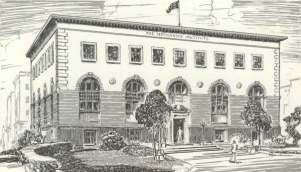1200 Atwater Ave., Westmount, Québec H3Z 1X4
History and Archives
 The Atwater Library traces its origins back to 1828, when the first mechanics’ institute established in continental British North America was formed in Montreal. Today, with its official name, Atwater Library and Computer Centre, it is the sole survivor of the many mechanics’ institutes established in Canada in the 19th century. The rest were either closed or merged into public library systems. The Atwater Library and Computer Centre carries on proudly, aware of its traditions, but focused on the future.
The Atwater Library traces its origins back to 1828, when the first mechanics’ institute established in continental British North America was formed in Montreal. Today, with its official name, Atwater Library and Computer Centre, it is the sole survivor of the many mechanics’ institutes established in Canada in the 19th century. The rest were either closed or merged into public library systems. The Atwater Library and Computer Centre carries on proudly, aware of its traditions, but focused on the future.
In 1828, some prominent Montreal citizens formed the Montreal Mechanics’ Institution because they saw a need to educate workers for the emerging industries of the growing city. Patron of the new organization was Sir James Kempt, governor of Lower Canada and the first president was Louis Gugy, sheriff of Montreal. Vice-presidents were industrialist John Molson; merchant Horatio Gates; Louis-Joseph Papineau, speaker of the Assembly of Lower Canada, and the Assembly’s representative from the west end of the city; and Rev. Henry Esson, educator and Church of Scotland pastor of the St. Gabriel Street Church. Active members appear to have been mainly artisans, craftsmen, and shopkeepers who were employers.
Continue reading about our early days, our Heritage building, or visit our Archives page, where you can download the Minutes of the organization, from 1828-1890.
More historical articles are found below.
Text and research by Susan McGuire.
News and Events
- History of the Mechanics Institute of Montreal
We trace our origins back to 1828, when the first mechanics’ institute established in continental British North America was formed in Montreal. Today, with our official name, Atwater Library and Computer Centre, we are the sole survivor of the many mechanics’ institutes established in Canada in the 19th century. The rest were either closed or merged into public library systems. We carry on proudly, aware of our roots, true to our founders’ vision, but meeting current community needs with modern technology.
- Original Leadership – 1828
The view of education that predominated in Anglican-dominated, early 19th century England looked with disfavour on educating the working classes. Anglican leaders believed national prosperity depended on the workingman’s hard work, deference, sobriety, and religious virtue.
- Original Leadership (Part II)
Montreal’s development into an industrial and manufacturing metropolis was spearheaded by men who belonged to the Montreal Mechanics’ Institution in 1828-35, and to the Mechanics’ Institute of Montreal after 1840. They included men of different skills in the building and shipping trades, as well as those who were architects, lawyers, doctors, bankers, grain merchants and retail merchants. These are some of them:
- Drawing Classes at the Mechanics’ Institute
In Montreal in 1828, the leaders of the new Mechanics’ Institution envisioned the establishment of classes in such subjects as writing, arithmetic, French, and various aspects of drawing. These would serve two purposes: provide a source of education for the young men who were flooding the city and had nowhere to learn except on the job; and keep them out of the pubs.
- Engraver William Leney, Artist Robert Sproule
Shortly after the Mechanics’ Institution was formed in 1828, William Satchwell Leney donated an engraved copper plate for “striking off the cards of the Institution.” In thanks, he was made a “Member for Life.”
How and why he came to Montreal is unclear. He was born in 1769 in London and, according to Britain’s Dictionary of National Biography, became an engraver accomplished in both line and stipple while studying with Peltro William Tompkins; he engraved several of the series produced in the 1790s by John Boydell for The Shakespeare Gallery.

.jpg)
